Dmitry Medvedev: "The fuel and energy complex accounts for over a quarter of the gross domestic product, almost 30 percent of the national budget, more than two-thirds of export revenue and a quarter of total investments."
Excerpts from Dmitry Medvedev's opening remarks:
The draft Energy Strategy until 2035 outlines the fuel and energy sector's development plans for the next 20 years, measures to make energy production a modern, efficient and safe industry, and decisions to be taken in the sphere of tariffs, taxes and investments.
The draft provides for two fuel and energy sector development scenarios: conservative and target-oriented.
The fuel and energy complex accounts for over a quarter of the gross domestic product, almost 30 percent of the national budget, more than two-thirds of export revenue and a quarter of total investments.
The model according to which the fuel and energy complex and the entire economy grow only at the expense of ever-increasing production at the already developed fields, and with growing energy exports, is no longer working to its full capacity. Easy money will be harder to come by. The 2035 Strategy should come up with production and energy consumption forecasts and substantiated solutions to numerous problems in the fuel and energy sector.
It is important to properly assess the changes taking place in the global energy sector. We can’t afford to ignore them, especially since we know that energy revolutions come around every 50-60 years, bringing new types of fuel, which ultimately changes the playing field.
We should be mindful that there are new producers that use innovative manufacturing and processing technologies. Global energy prices fell sharply, and the demand for energy is shifting towards developing economies. Of course, we must also keep in mind that the competition in the energy markets is becoming stronger each year.
Our fuel and energy complex must ensure our country’s security in full. Industrial and agricultural enterprises, utilities and households must receive all the energy they might need, and it must be of good quality and provided at reasonable prices. It is necessary to put in place special measures to increase domestic production of energy resources in northern and eastern Russia, and to develop the energy industry in our special regions, such as the Kaliningrad Region and the Crimean Federal District.
The use of energy must be taken to the next level. I’m talking about deep conversion of oil, gas, and coal; the use of a closed fuel cycle in nuclear power engineering; introducing modern production and transportation processes; and increasing the energy efficiency of the economy in general. The energy intensity of our GDP is still many times greater than that of other major developed and developing economies.
The energy sector generates a steady and, most importantly, effective demand for modern equipment, innovative technology and materials. This resource must primarily be used to expand our industry and our innovation-based research. We expect that import substitution efforts and the localisation of production, as well as technical alliances, will significantly reduce imports of equipment and materials for the fuel and energy sector. According to the draft strategy, their share should not exceed 10 percent by 2035.
We must maintain our leading positions in global energy production. It is imperative that we pursue a flexible export policy, expand the energy exports list, minimise costs and improve transport infrastructure for developing new fields and expanding exports. We must increase our presence in new fast-growing markets, primarily, the Asia-Pacific region, while honouring all our obligations to our European customers. Our goal for the next decade is to increase our oil and gas supplies to that region many times over.
The strategy must include a consistent sequence of Government actions to improve the investment environment in the energy sector. Russian businesses, foreign investors and foreign consumers should be provided with clear guidelines regarding taxation and customs regulations, and the tariff and pricing policy. These measures are designed to make energy markets more open, transparent and competitive, and thus, more effective and attractive for long-term investors.









